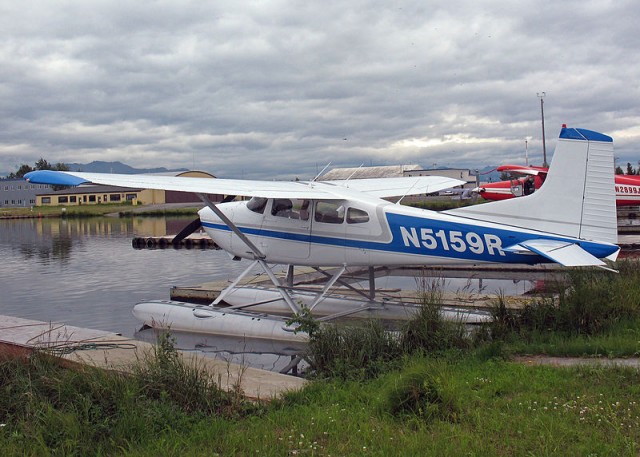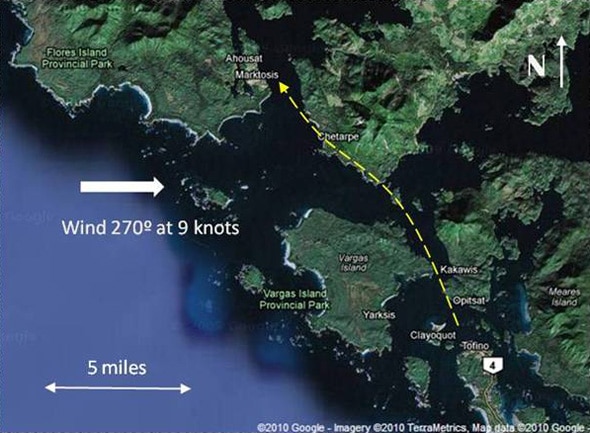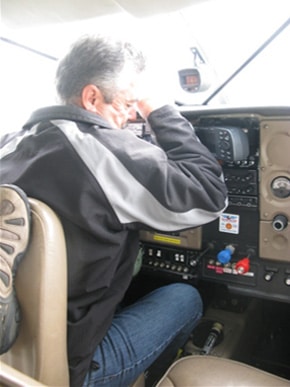Loss of Control – Collision with Water
Transportation Safety Board of Canada – Aviation Investigation Report A10P0147
Loss of Control – Collision with Water
Atleo River Air Service Ltd.
Cessna 185F, C-GIYQ
Ahousat, British Columbia
29 May 2010
The first thing that struck me about this TSB Canada report was the title. Loss of control seemed an odd description and certainly isn’t a cause in itself. The title fits the report, though: loss of control was the key factor in this investigation because to start, that was all the investigators knew. How did the pilot lose control and why did he fly the aircraft into the water at a 45° angle? That took longer to work out.

The aircraft was a Cessna 185F which had been fitted with floats to allow water landings. It was owned by Atleo River Air Service Ltd. The pilot, who was the company’s aircraft maintenance engineer, had 2,000 hours of flying logged, mostly in the Cessna 185 on the west coast of British Columbia. He was trained, qualified, certified and medically fit.
That day, he was approached by three passengers who wanted to charter the aircraft to take them back home to Ahousat First Nation, on the west coast of Vancouver Island. They had a small amount of baggage: several bottles of liquor, a case of beer and some personal effects.
They had travelled to Tofino by water taxi, but the operator would not take them back to Ahousat.
The Ahousat reservation is only accessible by water or air. The water taxi operator does not allow alcohol to be carried to Ahousat. As a result, the passengers decided to charter the aircraft. They had been drinking but were walking normally and “coherent enough to argue the price of the charter.”
The pilot agreed to take them for the six-minute flight to Ahousat.
They departed Tofino at 1200 Pacific Daylight Time. The route is usually flown at 300-500 feet above sea level. The weather visibility was 8 miles, with a layer of scattered cloud at 1,000 feet and overcast at 1,400 feet. That day, the Cessna flew VFR at about 500 feet.
Two nautical miles from Ahousat, in cruise, the aircraft descended in a steep-nose down attitude. It flew straight into the Millar Channel and overturned. Fishermen and water taxis in the area tried to keep the wreckage afloat but it sank in the 15 metres of water and came to rest on the ocean floor.

The front seat passenger died on impact. The pilot and the rear passengers suffered blunt force injuries which may have been fatal and certainly would have stopped them from being able to escape the underwater aircraft. Cause of death was drowning.
Two days later, divers found the aircraft wreckage with the pilot and all three passengers still inside. The pilot still had his lap belt on. The aircraft had shoulder restraints but the pilot did not have the shoulder restraint strap connected to his lap belt.
All of the passengers were unrestrained. The right door was ajar. Beer cans were found near the passenger seats.
The emergency locator transmitter functioned but no signal was received until the wreckage was brought to the surface.
The aircraft struck the water at about 45° nose down and sheared off the engine and the pontoons. The V brace, which forms a V between the top corners of the windshield and the top centre of the instrument panel, was bent forward.
The engine was running and the propeller damage was consistent with significant power at impact.
There was no indication of control malfunctions. The aircraft was trimmed for the cruise with the flaps fully retracted. The weather was good.
The aircraft did not spin nor stall. There was no evidence to suggest any mechanical or environmental cause.
The evidence was baffling. The captain had no known medical condition and there was no record of him being depressed or intending to harm himself. And yet, it appeared he’d flown the aircraft straight into the ocean.
Transportation Safety Board of Canada – Aviation Investigation Report A10P0147
The aircraft struck the water at an angle and speed consistent with a deliberate dive, or a loss of control. There is no operational reason why the pilot would perform such a manoeuvre. Had the pilot intentionally caused the aircraft to dive, a level-off should have been possible. Based on the pilot’s demeanour, there was no reason to dive to the point of impact with the water. Therefore, it is concluded that the pilot lost control of the aircraft.
The pilot’s lap belt showed evidence of high loads. The front passenger’s lap belt had no evidence of similar loads. The rear right passenger’s lap belt failed under load, indicating that it was being worn at impact. The rear left passenger’s lap belt showed no distress.
The autopsies showed high levels of alcohol in all the passengers.
The pilot’s right wrist was broken and he had a severe injury to his forehead.
The rear left passenger, sitting behind him, had two broken ankles.
A picture of the pre-accident situation began to form in the investigators’ minds.
The bent V brace and the pilot’s broken wrist were consistent with the pilot bracing himself, or trying to resist a force from behind. However, the autopsy showed no sign of a strike to the back of his head.
The passenger sitting behind him broke both ankles on impact, which suggests she was kicking or pushing the pilot’s seat forward. Investigators believe she may have kicked the seatback with both feet and then pushed it forward, forcing the pilot into the instrument panel and the controls into a dive.

[Our tests revealed] that if the pilot’s upper body is not secured by the shoulder harness, a rear passenger could push the pilot’s seatback forward causing the pilot to push the control yoke forward, thereby causing a nose down control input. It was noted that the pilot had no space to leverage his arms and push back sufficiently to overcome the passenger’s leg force from behind. In this scenario, a pilot could not resist a push from the back unless it was expected and the pilot braced accordingly.
The Transportation Safety Board of Canada determined that this was the most likely cause of the fatal accident.
Findings as to Causes and Contributing Factors
- It is likely that passenger interference caused the pilot to lose control of the aircraft whereupon it descended in a steep nose-down attitude until it struck the water.
- It is possible the passengers’ level of intoxication contributed to their inability to recognize the gravity of the situation and stop the interference in time for the pilot to regain control of the aircraft before impact.
- Because there was no locking mechanism on the pilot’s seatback, and because the pilot was not wearing his shoulder strap, he would have been unable to prevent his upper body from being forced onto the instrument panel.
I have to be honest, I’m not sure I would have thought twice about taking the three passengers in my plane in that circumstance, even though they’d been drinking. It was only a six minute flight, after all. My main worry would probably been that someone might be sick in my aircraft — experience with my son has shown me that it is impossible to get the smell out of the cockpit.
However, this accident has really brought it home to me how badly wrong it can go. I can only imagine what the poor pilot must have been thinking as he was smashed against the instrument panel, knowing they had only 500 feet. Every fatal accident is tragic but this is truly the stuff of nightmares.








Oh god, oh god, oh god. Is it possible to read these things without seeing the moments of horror immediately before impact? I’m not very good at it.
Agreed – I might not have thought twice with that short of a flight and those weather conditions. However, anyone who reads this will never (and I never have) fly without the shoulder strap.
Shoulder straps are mandatory for TO/landing but not in-flight ops?
I’m not sure shoulder straps are required at all. I’ll check.
Shoulder belts (if equipped) are required to be worn during taxi, takeoff and landing. Lap belts are required to be worn at all times when a “crewmember” is at their station.
What if the person in the back put their feet up instinctively before the plane hit the water? Same was thing as someone would put their hands up on the dashboard, and stomp the ground to brace themselves before a car accident?
What a horrible incident.
“…a rear passenger could push the pilot’s seatback forward causing the pilot to push the control yoke forward…”
I am very surprised by this. When they were younger, my kids would kick my driving seat in the car but the design of the seat meant it was not pushed forward. Sounds like the Cessna’s seats need to be fixed in the same way?